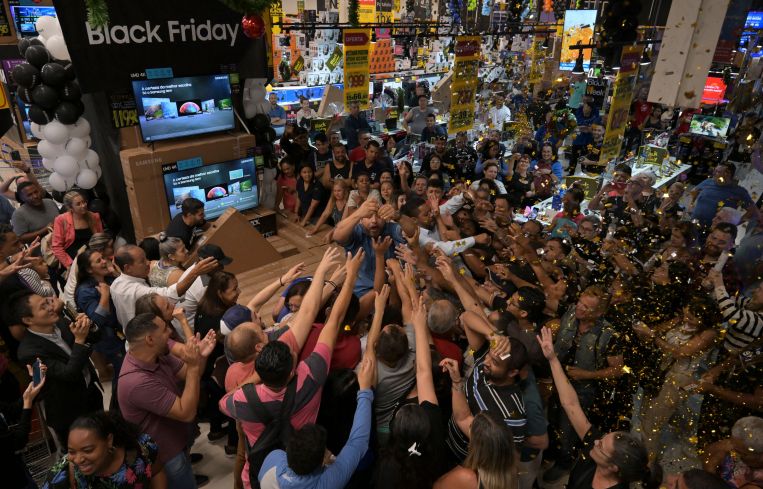Black Friday a Thing of the Past? Experts Say Early Sales May Harm In-Person Shopping
By Isabelle Durso November 28, 2024 9:00 am
reprints
It’s the holiday season, which means Black Friday is upon us.
The Friday after Thanksgiving has long been known as a day when shoppers flood malls and stores to wage battle amid sales and discounts, but some experts predict the chaotic shopping holiday could soon become a thing of the past.
“It’s a non-event,” Kate Newlin, a retail brand consultant and president of Kate Newlin Consulting, told Commercial Observer. “Early Black Friday sales are sucking any kind of adrenaline out of the system. It’s lost any sense of significance.”
Still, in-person shopping for Black Friday seemed to perform well last year. In 2023, the “holiday” saw a 300 percent increase in mall visits compared to the first week of November, according to data from location analytics company Placer.ai. Superstore chains like Walmart and Target also saw an 81 percent increase in foot traffic, the report found.
This year, superstores such as Kohl’s, Nordstrom and Ulta are expected to offer “deep discounts” on fashion and beauty products — a category that has been successful in driving foot traffic to stores over the years, according to Placer.ai. Classic retail brands like Calvin Klein, Levi’s and Ralph Lauren are also set to see an uptick in visits this year compared to last year, the report found.
And some experts are more optimistic about this year’s Black Friday turnout.
“I think we’re going to see a pretty strong holiday season from a visitation standpoint,” R.J. Hottovy, head of analytical research at Placer.ai, told CO. “Over the last two years, our data has shown that people continue to show up at stores for holidays and events around deals and promotions.”
Retailers have some reason for that optimism as U.S. retail sales are expected to reach $75 million in the days between Black Friday and Cyber Monday, according to Bain & Company’s report.
Some retailers started promoting Black Friday sales even earlier than normal this year to get customers “interested,” Hottovy said, but it’s possible those early sales will actually end up harming retailers’ in-store performance.
“It’s harming their foot traffic because they’re discounting the urgency to go into the store,” Newlin said. “Black Friday was relied on as a destination to go the day after Thanksgiving and get these amazing deals. Now you can get these amazing deals watching ‘Game of Thrones’ reruns from your sofa and do it without ever leaving home.”
Thanks to Cyber Monday deals and artificial intelligence-boosted promotions, online shopping has become a go-to alternative for consumers seeking convenience.
In 2023, Black Friday generated about $9.8 billion in online sales, representing an increase of about 7.5 percent from 2022, as CO previously reported.
“In the last couple of years, we’ve learned that it’s really kind of hard to do physical retail without online retail, and vice versa,” Hottovy said.
Even during the first quarter of 2024, e-commerce sales growth accounted for 57 percent of total U.S. retail sales growth, a report from FTI Consulting found. And as of October, 41 percent of shoppers said they increased their use of e-commerce sites compared to last year, Retail Dive reported.
Rebecca Homkes, a strategy specialist and business adviser, said retailers’ performance on Black Friday this year will likely depend on their adaptation to AI, as “customized campaigns, personalized marketing and speaking to the consumer as an individual” are integral parts of the modern shopping experience.
“Frankly, no one’s really nailed the omnichannel experience with AI yet, so I think there’s going to be a little bit of friction this Black Friday for those stores trying to do [both online and in-store deals] simultaneously,” Homkes told CO.
In addition to adapting to an ever-growing e-commerce market, big chain retailers also have to compete with small local shops, which have seen success post-pandemic and also offer their own Black Friday promotions. Last year, local stores accounted for 54.3 percent of all retail sales, according to a report from Capital One.
“A sense of significance is something you can get in an excellent shopping experience,” Newlin said. “What’s great about the small stores and the small wine shops is that sense of recognition that you walking in matters. Those small retailers are very well set up to do that.”
And as for malls, it seems that perhaps purely retail-based malls may face the “final nail in the coffin” this year, Homkes said.
“The mall is not dead, but the only mall that’s thriving is the experience mall,” Homkes said. “The malls that are optimizing for outdoor space, for retail, food, hospitality and entertainment, they’re going to have a great season.
“This could be the final nail in the coffin of many of these malls that have not made the adjustments,” Homkes added.
It remains to be seen how retailers will fare on this year’s Black Friday, but one thing is for sure: It’s not the same customer-drawing (sometimes fatal) spectacle it used to be.
Isabelle Durso can be reached at idurso@commercialobserver.com.


